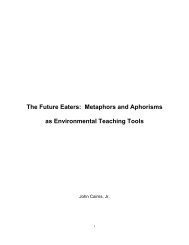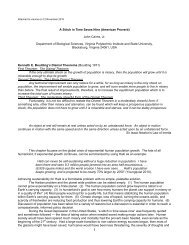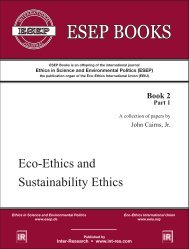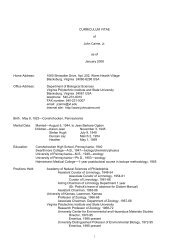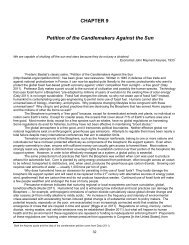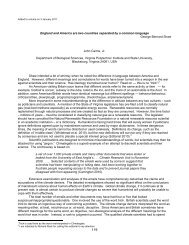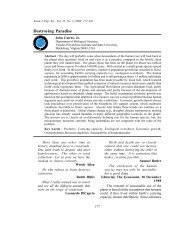You also want an ePaper? Increase the reach of your titles
YUMPU automatically turns print PDFs into web optimized ePapers that Google loves.
extramural funding. My mentor, Ruth Patrick, was a past master at acquiring grants and contracts, and, from 1948 to 1953, I<br />
was entirely dependent upon her for extramural funding. In 1953, I began to acquire grants and contracts on my own, but<br />
could not have survived as a research scientist without her help. Fortunately, I had taken <strong>Professor</strong> L. V. Heilbruns<br />
physiology course while a graduate student, so when Ruth Patrick acquired a grant to study the effects of increased water<br />
temperatures from power plants and reactors, I felt somewhat prepared. The research was on freshwater fish, invertebrates,<br />
and diatoms. Consequently, Ruth Patrick introduced me to studies on three levels of the aquatic food chain. The results<br />
were interesting, and I even was invited to present a paper at the 10 th Annual Purdue Industrial Waste Conference.<br />
<strong>Professor</strong> Don Bloodgood, who was in charge of the conference, published my paper and also saw that it was published in<br />
two parts in Industrial Wastes (<strong>Cairns</strong> 1956a,b). This valuable experience not only acquainted me with a new research area<br />
but also with the discipline of waste treatment engineering, which had money to support the research. Still, this new research<br />
area was another risky undertaking, which Jeannie fully supported. The risk turned out to be a justifiable one since a wide<br />
variety of engineers had become interested in toxicity testing. This research on toxicity of chemical substances to aquatic life<br />
continued through the 1950s to the early 1990s. In addition to engineering journals, I used Notulae Naturae of ANSP for<br />
publishing many papers. Classical biological journals did not welcome toxicity testing manuscripts, although they involved<br />
living material. The few journals that were willing to consider the manuscripts lacked experienced reviewers. In 1966, I<br />
managed to have an article in Progressive Fish-Culturist (<strong>Cairns</strong> 1966) and, in 1967, an article in Scientist and Citizen<br />
(<strong>Cairns</strong> 1967). Fortunately, engineering journals kept alive my hope that environmental toxicology would be accepted outside<br />
of engineering.<br />
In 1961, I began teaching, first at RMBL (1961-1963) and then at University of Michigan Biological Station (1964-<br />
1970), and I continued at these two field stations through 1994. In the academic year 1962-1963, I taught an all-day<br />
Saturday course in physiology for the National Science Foundation Institute to high school teachers. I enjoyed teaching, and<br />
now I had three courses I was confident in teaching in case my research career failed. Jeannie’s support never wavered<br />
despite the fact that, in 1963, I turned 40 years old and was working 60+ hours per week and still had not accomplished<br />
anything notable.<br />
Jeannie and I had always liked hiking in natural systems, but hiking developed into a necessity in 1961, our first year<br />
at RMBL. After that, we felt that a 1- or 2-mile hike daily, except in inclement weather, was a necessity. We felt serene<br />
hiking the Appalachian Trial or even the second growth forest in which our Virginia house was located. Some Indian tribes<br />
call trees “the standing people.” In Greek myths, spirits known as hamadryads dwelt in the trees of sacred groves (Little<br />
2008, p. xiii), but were not immortal – if a tree died, its spirit died with it. All old growth forests are sacred, but even second<br />
growth forests have a spiritual quality – both Jeannie and I felt this very strongly. Of course, we had hiked on the beach on<br />
Long Beach Island, New Jersey, where my father had a summer cottage, but not until we got to the Colorado mountains did<br />
daily hikes become a necessity. When we arrived at Virginia Tech in 1968, swimming 1 mile in indoor pools became a daily,<br />
weekday event. Of course, we had both swum as children, summers at Long Beach Island in the 1950s and summers in<br />
Douglas Lake at the University of Michigan Biological Station from 1964 through 1984, but the activity was then seasonal.<br />
In the late 1950s and early 1960s, I began to spend increasing amounts of time on administration. In 1960 and 1961,<br />
I had no journal articles, no books, no chapters in books edited by others, and not even a single abstract. This period was<br />
scary for a person who hoped for a research career with significant teaching responsibilities. Jeannie’s support never<br />
wavered, but I had significant doubts. I was in a new field, environmental toxicology, which was not exactly a “hot, new” field.<br />
However, I was confident it would become a major factor in environmental decisions, which it did.<br />
The Defining Decision<br />
In the mid-1960s, I decided I needed more control of my time to develop a computer interfaced toxicity monitoring<br />
system. I had been at ANSP (from 1948) for so long that colleagues assumed I was there for life. In 1965, I had only one<br />
tempting offer from a small, quality university, but it required major administrative time and starting a biology department that<br />
would award the BS, MS, and PhD degrees.<br />
Some of these events have been covered elsewhere in this autobiography, but I am emphasizing here the events<br />
that could have strained or destroyed the relationship between Jeannie and me. We both grew up in the Philadelphia area<br />
and had lived there for 43 years (1923-1966). We would be leaving a secure position at ANSP, family, friends, and the<br />
superb Lower Merion Township school system – all for the hope that I could manage to develop a significant research career.<br />
The best employment offer I had in spring 1966 was from the University of Kansas (KU). I gave the customary<br />
seminar and described my research plans to the faculty and various administrators. I was shown an old frame house and<br />
was asked if it would be suitable for my research; it would have been sufficient for the first phase. I assumed that, if my<br />
research was satisfactory, then more suitable space would be found. I never saw the house again, nor was it ever<br />
mentioned.<br />
When Jeannie and I went to KU, we assumed it would be for the rest of our lives. We were both 43 years old, and<br />
the typical faculty retirement age was 65. Shortly after I arrived, I was shown my “research space” on a take-it or leave-it<br />
basis. It was totally inadequate. My heart sank! What had I done to Jeannie and the children? I couldn’t bring myself to<br />
discuss it. I would simply work hard and hope for the best.<br />
Jeannie’s amazing adaptability soon resulted in: (1) starting a folk dancing group at KU, (2) getting deeply involved<br />
in Head Start, (3) becoming, as a couple, members of three square dance groups, and (4) joining the local Unitarian<br />
4



